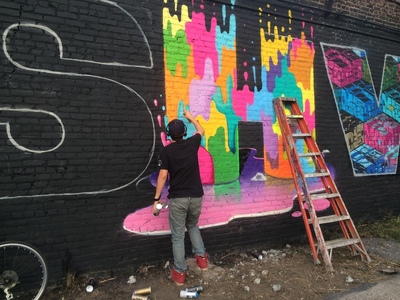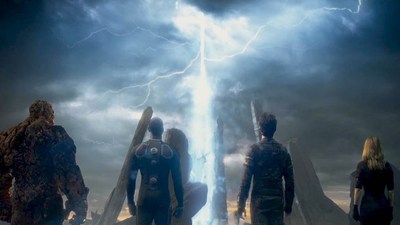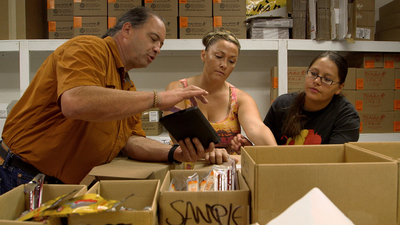
BY MATT BARONE |
VIDEO: "Rhythm of the City" The Art of BUA Through The Eyes of Julie Gratz
Tribeca presents an exclusive animated short inspired by NYC-raised artist Justin Bua’s one-of-a-kind drawings.
When was the last time you saw a boombox? You know, one of these ancient relics.
It’s crazy to think that, in today's era of iPods and streaming music services, there once was a time when rap fans walked around in public blasting their favorite songs through big, bulky, shoulder-resting speakers, on streets where dancers spun on flattened cardboard boxes.
Those old-school hip-hop elements are captured beautifully and hauntingly in "Rhythm of the City," which TribecaFilm.com is proud to premiere exclusively today. Directed and animated by Bushwick-based filmmaker Julie Gratz, it's a two-minute excursion into an otherworldly version of New York City in the 1980s, turning four classic paintings from acclaimed artist Justin Bua—or, simply, BUA—into one vibrantly lifelike trip, via the magic of Photoshop. Gratz's reinterpretations of BUA’s "The DJ," "1981" and "The Boombox" are backed by an original musical composition from collaborators DJ Qbert and world-renown cellist Dana Leong. The cumulative effect is like entering the mind of a two-headed Crazy Legs/Ralph Bakshi hybrid.
For BUA, animation isn’t a foreign terrain. He designed the opening credits for MTV's The Lyricist Lounge Show and oversaw Comedy Central’s animated series Urbania. But he’s the first person to say that what Gratz did with his paintings is something truly unique. "Julie came with something I really liked, which was taking my imagery and moving it without changing it or altering the images’ painted effects," says BUA. "It's kind of a throwback—it's an old-school approach to animation, and I loved that about it. She kept the integrity of my buildings and my characters."
Initially approached by their mutual friend Leong about doing something with BUA’s artwork, Gratz was struck by how unexpectedly surreal BUA’s images became once paired with Leong and Qbert’s hypnotic marriage of jazz and boom-bap. The artistic fusion yielded something that transcends time and place, even though BUA’s original paintings are firmly set in the '80s New York City, the time in which he came of age as a break-dancing B-boy. "I’ve talked to people who’ve been around New York for a long time and they’ve told me how this video makes them feel really nostalgic," says Gratz. "But at the same time, people who don’t know anything about the early days of hip-hop in New York City have also responded to it. The paintings are definitely New York, but for people who haven’t been to New York, BUA's paintings feel like they’re snapshots taken in they're own distinct universe."
Watch "Rhythm of the City" above for a first-class ticket to that other universe. Below, Gratz and BUA discuss what makes the video so unlike the rest of 2015 hip-hop.
Remixing BUA's Living, Breathing Artwork
"His paintings are so angular and have so much personality. He accentuates every little angle and aspect of each person and each building; he paints the buildings in the background with so much detail and gives his characters these distinctly exaggerated perspectives. It already looks like it's in motion and alive, so bringing it to life through animation makes sense. Because his backgrounds are so detailed, I was able to have you fly through one of the windows and head right into a different painting. I wanted it to be an immersive journey through these worlds that BUA created. Hopefully it lets people forget about where they are or what they’re doing and sucks them into this crazy alternate universe." —Julie Gratz
"I always hear fans say, 'Your work lends itself to animation, and to move.' My characters are crazy, weird, and full of personality and life, and I would say the same about my buildings—my buildings are also characters. Usually in animation, there’s a saying, 'Background is background for a reason,' so if you have buildings in the background, don’t make them full of too much personality, because that will distract from what’s in the foreground. But I like my backgrounds to be foregrounds, and to be characters that play along in the scene." —BUA
Blending Hip-Hop's Old With the New
"I came up as a B-boy and a graffiti writer in New York City, so my images are true to my culture. I capture the nascent moments and the local heroes and celebrities of my time. That’s just part of who I am: the break-dancer, the DJ, that entire world. I was at a school where I was a freshman and Slick Rick was a senior, and he was in a crew called the Kangol Crew; they were always performing in the lunchroom where I was dancing. So these images you see in Julie’s film were ruminating in my imagination when I was 14, 15 years old. They're true to my life."
"But these images aren’t necessarily true-to-life for younger people today. My daughter would probably think a boombox is a bizarre concept—she’s so used to holding a little iPod. The idea of someone walking around and playing their music for everyone else to here is kind of antiquated now. People can’t really understand that. I’m 47, and Julie is a lot younger than that, so we come from two different eras of hip-hop. Hip-hop today isn’t what hip-hop was when I was growing up. What’s so successful about Julie’s film, though, is that it has a really strong sense of timeliness and placelessness." —BUA
To check out more of Justin Bua's artwork, and to buy pieces of it, visit his personal site. You should also follow him on Instagram.
For more info on Julie Gratz and her production company, KALEIDA Vision, head over to their official site.

